We may not have the course you’re looking for. If you enquire or give us a call on +852 2592 5349 and speak to our training experts, we may still be able to help with your training requirements.
Training Outcomes Within Your Budget!
We ensure quality, budget-alignment, and timely delivery by our expert instructors.
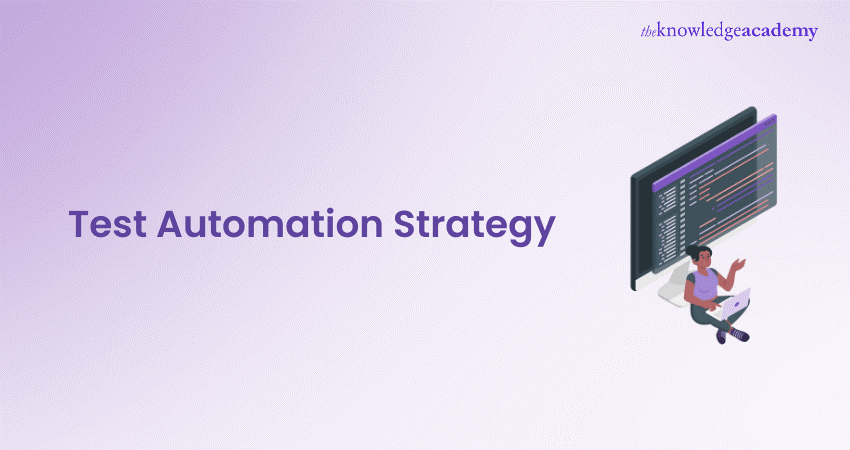
Creating a Test Automation Strategy is like drawing a roadmap to success for your software development journey. Imagine having the ability to catch bugs before they infiltrate production, accelerate your testing cycles, and free up valuable time for your team—all effortlessly. That’s the magic of a well-crafted Test Automation Strategy.
With a robust Test Automation Strategy, you can proactively identify and eliminate bugs before they affect your users, significantly reduce testing time, and streamline your release process. In this blog, we’ll explore the essentials of crafting a Test Automation Strategy that’s not only effective but also adaptable to your evolving needs.
Table of Contents
1) What is Automation Testing?
2) Test Automation vs Manual Testing
3) What is an Automation Testing Strategy?
4) The Need for an Automation Testing Strategy
5) Consequences of Not Implementing Automation Testing Strategy
6) Types of Automated Tests
7) The Benefits of a Test Automation Strategy
8) Key Steps to Build an Effective Automation Testing Strategy
9) Conclusion
What is Automation Testing?
Automation Testing enhances software quality, reduces deployment times, and lowers development costs. However, to maximise these benefits, it’s crucial to avoid common pitfalls by developing a strategy based on best practices.
Key Points:
a) Tightening Feedback Loops: Automation Testing reduces the time to feedback, allowing for more frequent deployments and faster user feedback.
b) Efficiency: Instead of waiting a day or two for QA to show regression results, automation can provide them in minutes.
c) Strategic Approach: Automated tests should be part of a well-thought-out strategy that:
a) Identifies priorities in workflows.
b) Selects the right cases to automate.
c) Avoids common anti-patterns.
Test Automation vs Manual Testing
Manual testing involves executing tests manually by a QA Consultant or team, verifying outcomes, and documenting results. It's ideal for early-stage UI testing, usability, exploratory, and ad-hoc testing. In contrast, Test Automation uses scripts to run tests quickly and accurately, making it suitable for regression, end-to-end, and stable UI testing. Below are detailed pros and cons of both testing approaches:
Manual Testing
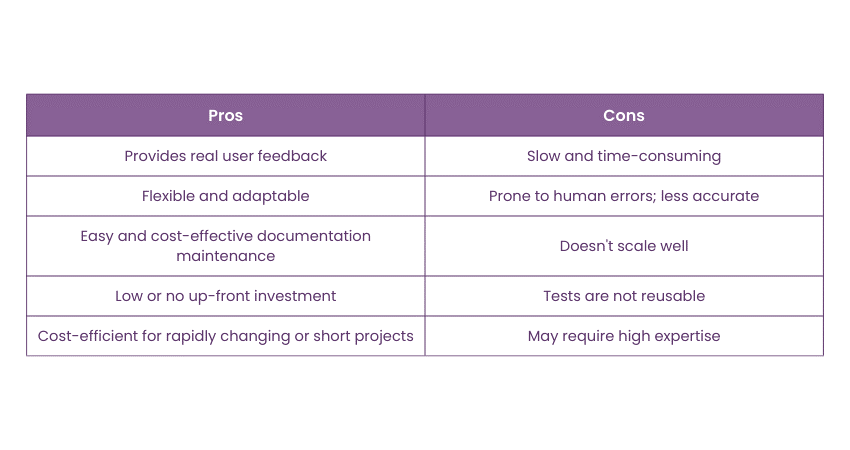
Key Benefits:
a) Feedback: Manual testing offers valuable feedback on user experience and improvement suggestions, enhancing the overall quality of the product.
b) Flexibility: It allows testers to adapt quickly to changes using intuition and product knowledge, unlike automated tests, which fail until they are updated. b. Documentation Maintenance: Requires minimal technical expertise to maintain documentation, making it accessible to new QA team members.
c) Low Up-Front Investment: Little preparation is needed, enabling testing to start quickly, even with incomplete features like designs and flow charts.
d) Rapid Changes and Short Projects: Ideal for projects with frequent changes or short durations, as setting up automation may take longer than manual testing.
Test Automation
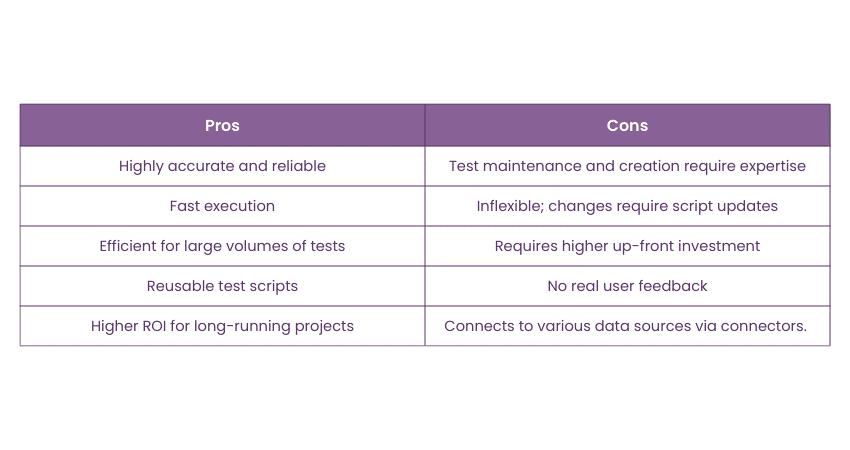
Key Benefits:
1) Accuracy and Reliability: Automated testing reduces human error, with precise and consistent actions. Some frameworks also provide session recording on failures, aiding in issue reproduction.
2) Speed: Reduces testing time drastically, making it ideal for frequent releases. Automated tests can perform tasks in seconds that might take minutes or hours manually.
3) Handling Large Volumes of Tests: Efficiently manages large test sets through parallel execution, unlike manual testing, which can become costly and error-prone as test sets grow.
4) Reusability: Once automated scripts are set up, they can be reused with minimal adjustments, lowering long-term maintenance efforts.
5) ROI for Long-Running Projects: Despite higher initial setup costs, automation becomes more cost-effective over time, particularly in long-term projects where tests are reused frequently.
Both manual testing and test automation have unique benefits and are essential to a well-rounded testing strategy. Manual testing is best for projects requiring adaptability and real user feedback, especially in rapidly changing environments. Conversely, test automation excels in providing accuracy, handling large volumes of tests, and boosting efficiency in long-term projects. The optimal approach often involves a combination of both, tailored to the specific needs of the project.
What is an Automation Testing Strategy?
The Automation Testing Strategy is a comprehensive plan that outlines how Automated Testing will be integrated into the Software Development Lifecycle.Let's break down the key elements of understanding a Test Automation Strategy:
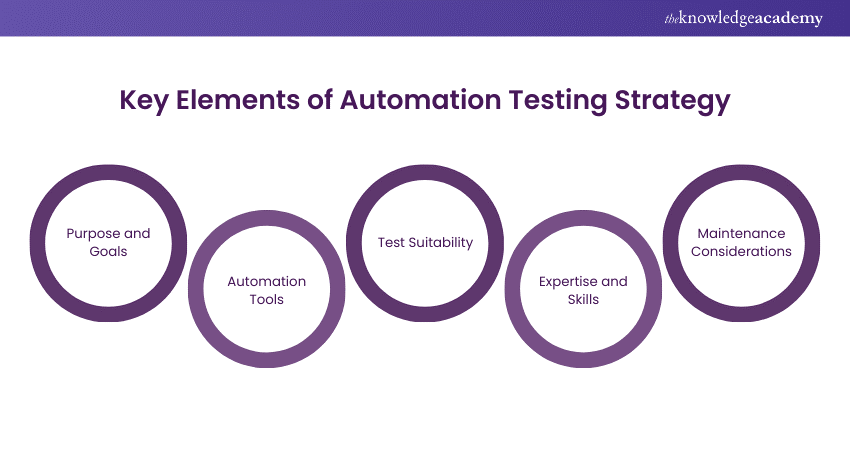
a) Purpose and Goals: The first step in understanding Automation Testing Strategy is grasping its purpose. It aims to enhance testing efficiency and effectiveness, with goals encompassing accelerated testing, improved coverage, early defect detection, and reduced manual intervention.
b) Automation Tools: Central to Test Automation Strategies are the tools facilitating automated tests. These tools range from open-source solutions to commercial products. Understanding tool capabilities and limitations is pivotal in selecting the most fitting options for the project's requirements.
c) Test Suitability: Not all tests are ideal for automation. A vital aspect of understanding the strategy involves identifying suitable test types. Repetitive and time-consuming tests that require minimal human judgment are prime candidates.
d) Expertise and Skills: Automation demands specialised skills. Understanding the strategy entails acknowledging the expertise needed for creating and maintaining automated test scripts. Teams must possess programming acumen, grasp testing frameworks, and exhibit proficiency with the chosen tools.
e) Maintenance Considerations: Automation Testing isn't a one-off endeavour. Scripts demand consistent updates as the application evolves. Thus, understanding the strategy involves recognising the need for ongoing maintenance and updates to ensure test accuracy and relevance.
The Need for an Automation Testing Strategy
Within the domain of Software Development, a Test Automation Strategy holds paramount importance. This meticulously crafted approach, leveraging automation tools and techniques, offers a spectrum of compelling reasons that emphasise its indispensability. Let's delve into these reasons to uncover why this strategy is not only advantageous but also imperative:
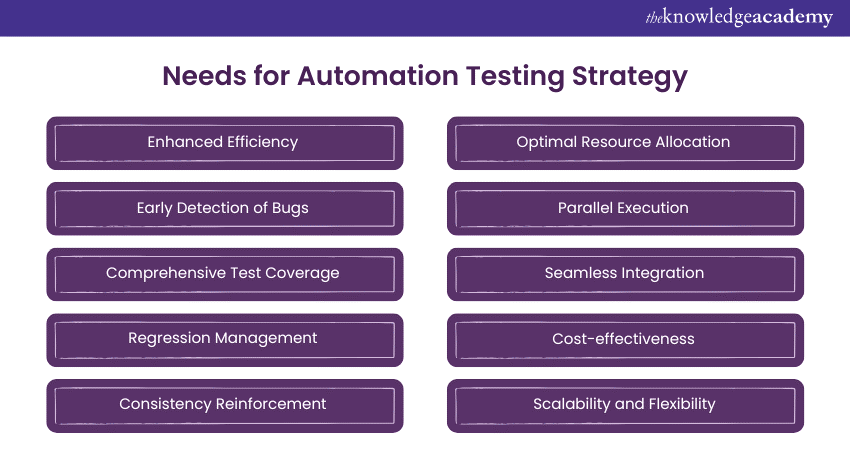
a) Enhanced Efficiency: Automates repetitive tasks, speeding up the testing process and software development lifecycle.
b) Consistency Reinforcement: Ensures precise, error-free test execution, leading to reliable results.
c) Early Detection of Bugs: Quickly identifies defects, preventing them from becoming major issues.
d) Comprehensive Test Coverage: Covers a wide range of scenarios, ensuring thorough evaluation.
e) Regression Management: Efficiently handles regression tests, maintaining stability with each code change.
f) Optimal Resource Allocation: Frees testers for more complex tasks, improving overall testing quality.
g) Parallel Execution: Runs tests concurrently, reducing testing timelines and time-to-market.
h) Seamless Integration: Integrates with development pipelines, providing rapid feedback and promoting agility.
i) Cost-effectiveness: Long-term savings through reduced manual efforts and faster defect identification.
j) Scalability and Flexibility: Adapts to project growth, accommodating increasing testing demands.
Consequences of Not Implementing Automation Testing Strategy
Neglecting a Test Automation Strategy can expose Software Development projects to several critical risks. Let's explore the potential pitfalls of not embracing this crucial approach:
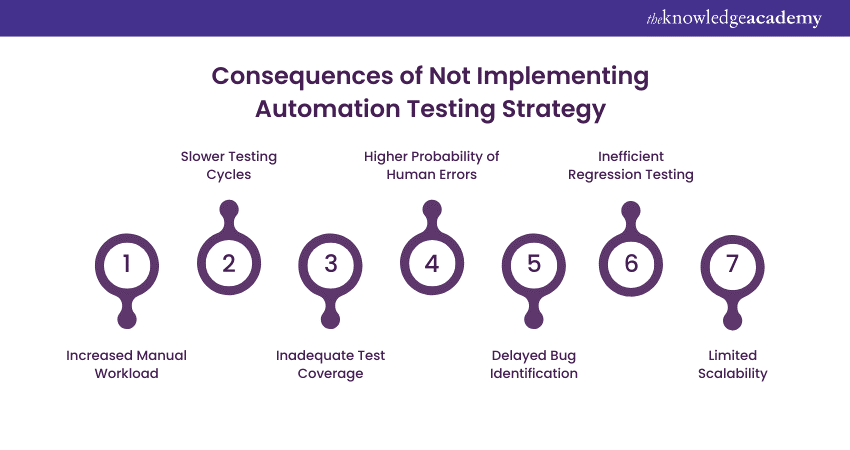
a) Increased Manual Workload: Without automation, repetitive and time-consuming tasks fall on testers, reducing efficiency and productivity.
b) Slower Testing Cycles: Manual testing takes longer, delaying development timelines and market releases.
c) Inadequate Test Coverage: Limited time and resources mean fewer scenarios are tested, risking undiscovered defects.
d) Higher Probability of Human Errors: Repetitive tasks increase the likelihood of mistakes, affecting software quality.
e) Delayed Bug Identification: Bugs are often found later, making them harder and costlier to fix.
f) Inefficient Regression Testing: Manual regression testing is cumbersome and resource-intensive, slowing progress.
g) Limited Scalability: Manual testing struggles to keep up with project growth, leading to resource strain and potential burnout.
Types of Automated Tests
Different types of Automation Testing are available to help you make informed decisions about which would deliver optimal results for your organisational structure. Let's explore them in detail.
The two main testing types are:
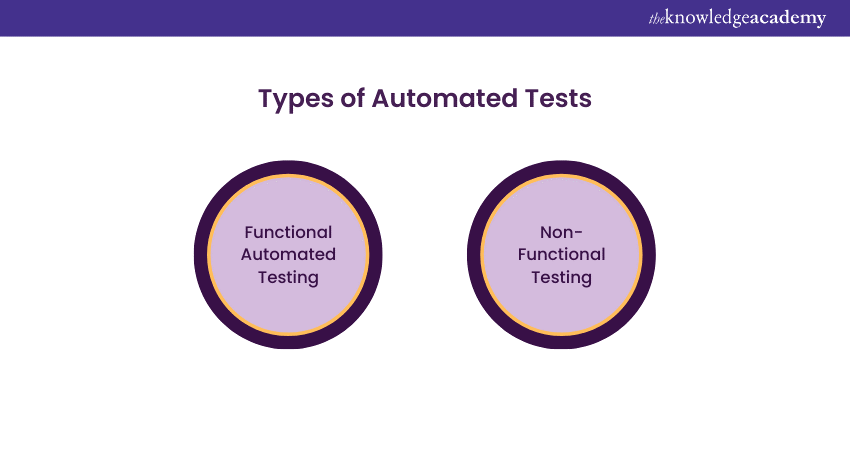
1) Functional Automated Testing: Functional Automated Testing checks if an application’s characteristics align with the expectations requirements. For example, if you can share notes with other users.
2) Non-Functional Testing: Non-functional testing checks other requirements, such as accessibility, performance, security, and usability. For example, it tests whether an application can handle high traffic.
There are other types of tests, which include:
1) Performance tests: Performance tests check the system performance by examining response times and stability during the load.
2) Security tests: Security tests check security issues that could lead hackers to take data.
3) Accessibility tests: Accessibility tests make sure that applications can be accessed by everyone with different demands, such as individuals with vision, hearing, or other impairments.
4) Usability tests: Usability tests check whether the system is easy to use. They are conducted by real users under conditions matching real use.
5) UI tests: UI tests focus on users' graphical interfaces and how they work on different device types, such as desktops, tablets, and smartphones.
6) Smoke tests: Smoke test checks the functionalities of the applications or further testing required
7) Regression tests: Regression tests involve running functional and non-functional tests again to ensure that no new issues are introduced into a previously functional application.
Master performance testing with our JMeter Training Course! Boost your skills and optimise applications. Join today and get started!
The Benefits of a Test Automation Strategy
One of the most important ways to ensure effective software testing is through a well-developed strategy for automating tests. It will help not just the process of testing but also encourage a culture of efficiency, quality, and adaptability in today's fast-paced environment of software development. The Four Key Advantages of a Strategy for Automating Tests are:
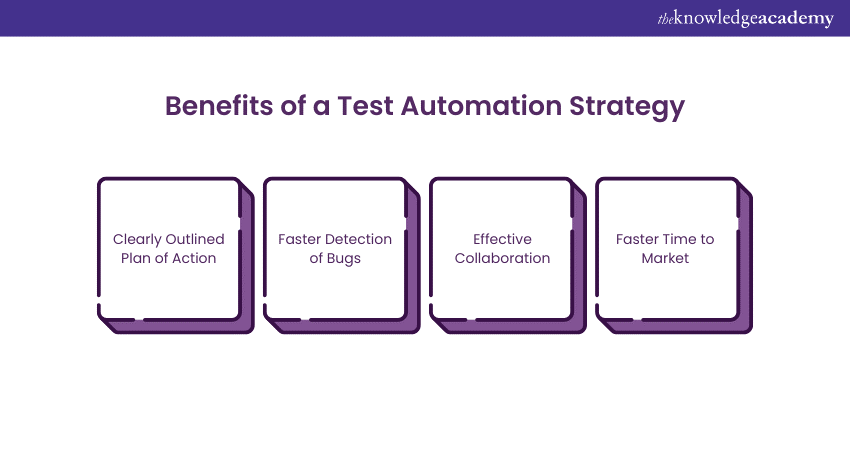
1) Clearly Outlined Plan of Action:
Some of the key benefits a strategy for the automation of tests provides includes giving a systematic and effective roadmap for the implementation of automation. This structured approach, in turn, offers several advantages such as quicker bug detection, collaboration, and time to market.
2) Faster Detection of Bugs:
A well-defined Test Automation strategy implies testing processes are slick and automated. Automated tests run much faster compared to manual tests, which helps in the quick detection of bugs and problems present in the software.
Continuous testing across the software development lifecycle, from early development to even after release, helps catch bugs at an early stage. Cost and effort towards bug fixation thereby decrease accordingly.
3) Effective Collaboration:
An automation strategy clearly defines the objectives and roles of the team members involved in testing. It delineates responsibilities, procedures, and communications that would ensure better collaboration among developers, testers, and other stakeholders involved. Automation tests give consistent and repeatable results since there is no room for ambiguity or disputes arising from human interpretation.
4) Faster Time to Market:
Automating tests provides much quicker feedback about the quality of the software. Hence, changes and fixes can be made in time. In this respect, shorter loops are obtained during the development process. Automated regression testing ensures that new features or changes do not introduce new defects. Thus speeding up the release cycle and allowing the product to be released much more often.
Key Steps to Build an Effective Automation Testing Strategy
Creating a robust Test Automation Strategy entails adopting a systematic and purposeful approach that guarantees effectiveness and efficiency throughout the Software Development process. By meticulously outlining the essential steps required to construct a successful strategy, you can establish a solid framework for streamlined testing practices:
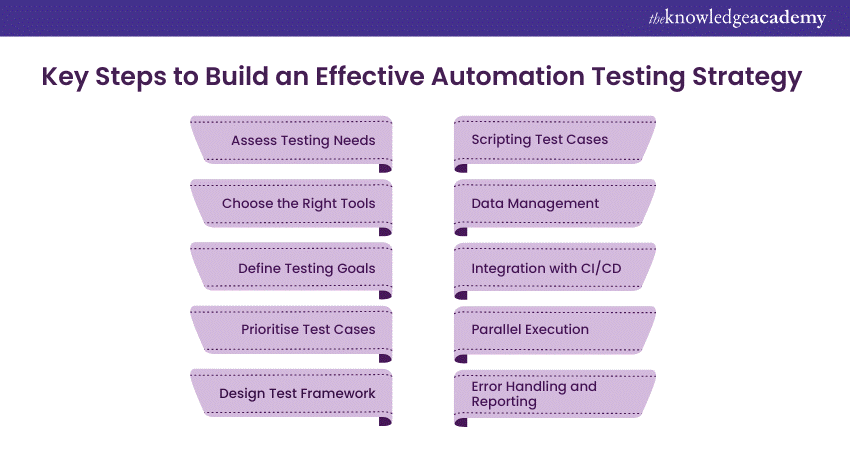
a) Assess Testing Needs: Commence by gaining a comprehensive understanding of the project's scope, overarching objectives, and specific requirements. This meticulous assessment serves as the bedrock for identifying the precise areas within the project that stand to benefit the most from automation. Factors such as test frequency, scenario complexity, and the stability of functionalities are pivotal in guiding this strategic decision-making process.
b) Choose the Right Tools: The selection of the appropriate automation tools carries significant weight. These tools should be chosen based on their alignment with the unique needs of the project, encompassing its technology stack and the proficiency levels of your testing team. Elements such as supported scripting languages, compatibility across diverse platforms, and seamless integration capabilities warrant careful consideration.
c) Define Testing Goals: The establishment of well-defined and quantifiable testing goals is paramount. These goals encompass a wide spectrum, ranging from the expansion of test coverage to the reduction of testing timelines and the augmentation of defect detection rates. A crystallised set of goals provides a navigational compass for your automation endeavours, enabling you to prioritise and channel efforts strategically.
d) Prioritise Test Cases: The reality dictates that not every test case is an ideal candidate for automation. A judicious approach involves prioritising high-impact scenarios, regression tests, and repetitive tasks that are inherently susceptible to human errors. This targeted approach ensures that your automation initiatives centre around pivotal functionalities and economise time where manual testing would yield diminishing returns.
e) Design Test Framework: The architecture of a well-structured and adaptable test framework assumes paramount significance. This framework serves as the scaffold for your automation strategy, delivering a standardised blueprint for test scripts, reusable components, and libraries. An inherently modular framework simplifies maintenance efforts and serves as a scalable foundation.
f) Scripting Test Cases: The crafting of articulate and concise test scripts through the designated automation tools is fundamental. Imbue your scripts with impeccable documentation, ensuring that they adhere to prevailing coding best practices. This meticulous scripting process facilitates seamless collaboration, engenders comprehension, and fosters the sustained maintenance of your test suite.
g) Data Management: The orchestration of a comprehensive strategy for effective test data management is pivotal. Irrespective of whether you employ real, synthetic, or anonymised data, the crux lies in addressing a broad spectrum of conceivable test scenarios. Prudent data management guarantees exhaustive testing coverage across a multitude of scenarios.
h) Integration with CI/CD: Seamlessly embedding your automation endeavours within the continuous integration and deployment (CI/CD) pipeline is non-negotiable. Automate the execution of tests that are catalysed by code commits, thereby effecting a rigorous validation process before any deployment occurs.
i) Parallel Execution: An adept strategy includes designing your framework to accommodate parallel test execution across diverse environments, browsers, or devices. Parallel execution truncates testing durations, delivering swifter feedback to developers and mitigating bottlenecks.
j) Error Handling and Reporting: The incorporation of robust error-handling mechanisms within your automation framework is of paramount importance. These mechanisms encompass the systematic capture and articulate reporting of failures. A comprehensive reporting mechanism expedites the analysis and resolution of issues, contributing to a more efficient testing cycle.
By unwaveringly adhering to these meticulously delineated steps, you establish a solid foundation for a thoroughly structured Automation Testing Strategy. Such a strategy is poised to not only amplify the efficiency and reliability of your testing processes but also to significantly elevate the overall quality trajectory of the software development lifecycle.
Boost your expertise with ISTQB Advanced Test Automation Engineer certification! Master advanced techniques and lead successful automation projects.
Conclusion
A well-crafted Test Automation Strategy is essential for improving software quality, speeding up development, and reducing costs. By leveraging the strengths of both automated and manual testing, you can achieve faster execution, greater accuracy, and more comprehensive test coverage. We hope this blog has given you valuable insights into crafting an effective Test Automation Strategy and inspires you to elevate your testing process.
Unlock the potential of Automation Testing with our Automation Testing Training Using TestComplete - Sign up now!
Frequently Asked Questions

A Test Strategy is typically written by a Test Manager or QA Lead. They outline the testing approach, objectives, resources, schedule, and scope. The document ensures the testing aligns with the project's goals, guiding the QA team throughout the software development lifecycle.

RTM stands for Requirements Traceability Matrix. It's a document that maps and traces user requirements with test cases, ensuring all requirements are covered by tests. RTM helps track testing progress, verifies coverage, and ensures no requirements are missed during the testing process.

The Knowledge Academy takes global learning to new heights, offering over 30,000 online courses across 490+ locations in 220 countries. This expansive reach ensures accessibility and convenience for learners worldwide.
Alongside our diverse Online Course Catalogue, encompassing 17 major categories, we go the extra mile by providing a plethora of free educational Online Resources like News updates, Blogs, videos, webinars, and interview questions. Tailoring learning experiences further, professionals can maximise value with customisable Course Bundles of TKA.

The Knowledge Academy’s Knowledge Pass, a prepaid voucher, adds another layer of flexibility, allowing course bookings over a 12-month period. Join us on a journey where education knows no bounds.

The Knowledge Academy offers various Software Testing Course including Software Testing Foundation Course, Advanced Level Test Analyst Course and Advanced Test Automation Engineer Course. These courses cater to different skill levels, providing comprehensive insights into Security Testing in Software Testing.
Our Business Analysis Blogs cover a range of topics offering valuable resources, best practices, and industry insights. Whether you are a beginner or looking to advance your skills as a Software Tester, The Knowledge Academy's diverse courses and informative blogs have you covered.
Upcoming Business Analysis Resources Batches & Dates
Date
 ISTQB Software Testing Foundation
ISTQB Software Testing Foundation
Mon 3rd Feb 2025
Mon 12th May 2025
Mon 21st Jul 2025
Mon 10th Nov 2025







 Top Rated Course
Top Rated Course



 If you wish to make any changes to your course, please
If you wish to make any changes to your course, please


